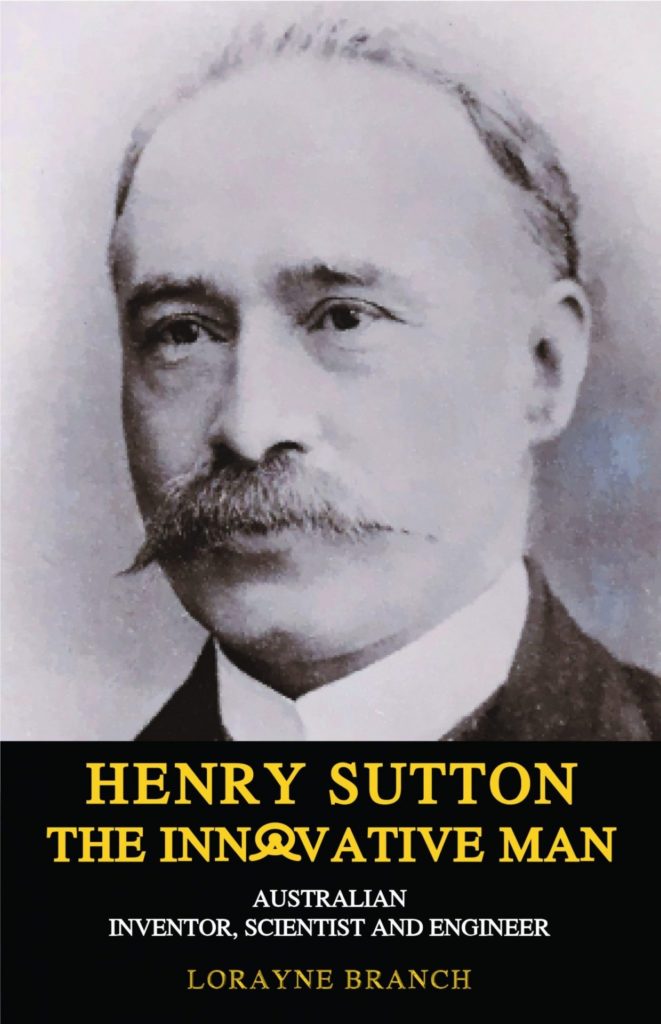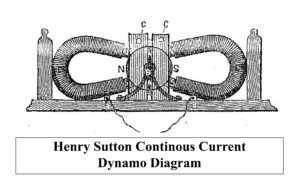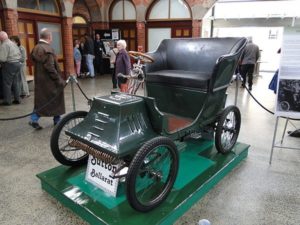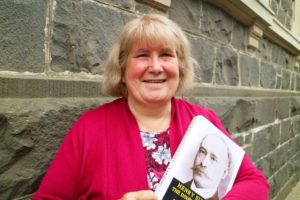Life of the Innovative Man
by Dr Douglas McCann MRSV
 A review of Henry Sutton: The Innovative Man: Australian Inventor, Scientist and Engineer by Lorayne Branch
A review of Henry Sutton: The Innovative Man: Australian Inventor, Scientist and Engineer by Lorayne Branch
The Australian inventor Henry Sutton was by any account an outstanding achiever and a prolific innovator. He was certainly on a par with many of the greatest modern inventors, but few people have ever heard of him or have any knowledge of his contributions. The recent release in December 2018 of the book Henry Sutton The Innovative Man: Australian Inventor, Scientist and Engineer detailing his life and accomplishments is thus a long overdue study of a noteworthy figure in the history of science – not just in the history of Australian science, but international science generally.
The author Lorayne Branch is Henry Sutton’s great-granddaughter and the book is the culmination of ten years of research in which she travelled Australia and overseas to source little-known and long forgotten references and publications. In late 2013 she moved from her home in Brisbane to Ballarat, Henry Sutton’s home town, so that she could immerse herself into the local community and gain a greater appreciation of the city, and the historical milieu of Sutton’s roots. Of course, because the author is Sutton’s great-granddaughter the book is more than merely an impersonal technical history, but a labour of love, and partly a family history as well … although that aspect is generally kept in perspective. The book is almost 400 pages and contains an appendix of over 100 pages that gives particulars of Sutton’s patents as well as detailed endnotes containing reproductions of relevant papers, letters, journal and newspaper articles, and a bibliography of archival sources. The result is a stunning and almost unbelievable catalogue of achievements by this largely unknown and unappreciated inventor.
The book contains sixteen chapters which cover Sutton’s life from his birth at Ballarat in 1855 during the height of the gold rush to his untimely death at Malvern in 1912. The chapters explicate the large range of technical areas in which Sutton laboured and mastered. He was a committed and apparently near-obsessive worker, and packed in a wide variety of activities into his lifetime despite his relatively early death at age 56. He was an intuitive designer and a gifted engineer and constructed original or improved designs of a large number of machines and scientific devices. The period when Sutton grew up, in the late 19th century, was a prime time for inventors such as Thomas Edison, Nikola Tesla and Alexander Graham Bell and for the introduction of new technologies. The earlier industrial revolution had provided the impetus and inspiration for the transformation of traditional society and the introduction of new scientific ideas, technologies and engineering practices. The introduction of electric power generation and the telegraph in particular led to a revolution in communication, industry, employment and recreation. Although relatively isolated in Australia Henry Sutton was also a major innovator of the period and befriended both Tesla and Bell. Some of the domains in which Sutton contributed include: aviation, battery storage, telephony, lighting, photography, printing, bicycle and car design and manufacture, wireless telegraphy or radio … plus a number of other technologies.
Henry’s parents Richard and Mary Sutton founded a music business in 1854 in a tent on Bakery Hill on the Ballarat goldfields, which later became the well-known Sutton’s Music Store in Sturt Street. Henry was born the following year. Initially he was home educated by his mother, and at 10 years of age he began to study the flight of birds and insects. He carried out some experiments, recording the flutter of insect wings against smoked glass, and by age 14 had developed his own theory of flight. In 1870 he built a manoeuvrable model ‘ornithopter’ which could fly in a circumference of 12 feet. These experiments with heavier-than-air materials for flight are regarded as the first to be carried out in Australia. Later, in 1878, two of his papers on flight were published by the Aeronautical Society of Great Britain. Henry, alongside his siblings, worked in the music store but his main interest was science and engineering. He is reputed to have read all the scientific books in the Ballarat Mechanics’ Institute by the time he was 14.
 An analogous story to the development of the model ornithopter is repeated many times by the author when she describes the development by Henry Sutton of a plethora of other machines and devices. For example, also in 1870, he developed an electric continuous current dynamo with a practical ring armature which was comparable to a later version by Belgian inventor Z. T. Gramme using similar principles as Sutton. There were a large number of parallel developments going on during this period. Alexander Graham Bell was issued his patent for the telephone on 7 March 1876 and after reading a brief account in Scientific American within six months Sutton had developed over 20 different versions. Although Sutton did not patent his own versions, 16 of these designs were subsequently patented by others. In 1878 he invented the first telephone handset. Sutton and Bell began corresponding and in 1910 Bell visited Sutton in Australia during a world tour. He was escorted to Ballarat by Sutton, where they exchanged ideas and examined Sutton’s sophisticated telephone system networked around the building at the Sutton family’s music store.
An analogous story to the development of the model ornithopter is repeated many times by the author when she describes the development by Henry Sutton of a plethora of other machines and devices. For example, also in 1870, he developed an electric continuous current dynamo with a practical ring armature which was comparable to a later version by Belgian inventor Z. T. Gramme using similar principles as Sutton. There were a large number of parallel developments going on during this period. Alexander Graham Bell was issued his patent for the telephone on 7 March 1876 and after reading a brief account in Scientific American within six months Sutton had developed over 20 different versions. Although Sutton did not patent his own versions, 16 of these designs were subsequently patented by others. In 1878 he invented the first telephone handset. Sutton and Bell began corresponding and in 1910 Bell visited Sutton in Australia during a world tour. He was escorted to Ballarat by Sutton, where they exchanged ideas and examined Sutton’s sophisticated telephone system networked around the building at the Sutton family’s music store.
Although he designed and constructed a large number of original or modified devices Sutton only took out a limited number of patents, in fact, only about 35 in all. That figure includes concurrent patents taken out in different countries. In general Sutton altruistically believed in offering the fruits of his scientific research to the world. In some cases he took out a patent but never tried to protect it or financially benefit from it. In other cases, such his new colour printing process, he did attempt to get them on the local and London markets but with limited commercial success. He was primarily a researcher, innovator and inventor, not an entrepreneur.
Papers on two of Sutton’s most internationally acclaimed inventions were published in the 1881 Transactions of the Royal Society of Victoria (issued in 1882). The first paper was titled ‘On a New Form of Secondary Cell for Electrical Storage’. In 1880, Robert Ellery, the Government Astronomer and the President of the Royal Society of Victoria, wrote to Sutton and asked if he was able to devise an improved battery for the Victorian Torpedo Corps. In August 1881 Sutton demonstrated a new battery to Ellery who immediately recognised it as a significant step forward in battery design. Sutton was urged to protect and patent the invention although his initial preference was to offer the design free to the world. It was decided to publish two versions of the paper on the battery. One was sent to the Royal Society of London and the other was kept under wraps to be read at the Royal Society of Victoria following the London reading. As it turned out the Victorian reading took place on 9th December 1881 and the London reading a few days later on 15th December. Sutton’s battery was exhibited at the 1882 Crystal Palace Electrical Exhibition in London and it brought him world acclaim. Thomas Edison acknowledged it as the world’s best battery at that time. Ironically there was some negative feedback from some Ballarat citizens who thought that Ellery and the Royal Society of Victoria, out of jealousy, were not giving due recognition to Sutton’s achievement, but it was more in deference to the Royal Society of London that publication and celebration of his invention was slightly delayed. Also, in science and technology, often it is only well informed contemporaries or colleagues who can accurately appreciate or understand another scientist’s achievements. Nevertheless, as the author states, it does seem true that in the longer term Sutton was never locally accorded the recognition he achieved internationally and which he truly deserved.
 The second paper published in the 1881 Transactions of the Royal Society of Victoria was simply titled ‘Description of Vacuum Apparatus’ (the diagram from the paper is provided, left). The paper was also published in ‘The English Mechanic and World of Science’. Sutton’s mercury air pump created a near perfect vacuum. His invention was again a considerable improvement on existing technology and again he declined to patent it, preferring to give it to the world gratis for the benefit of all. Both Joseph Swan and Thomas Edison used the design in the production of their incandescent light globes. The vacuum pump was used in the medical field in hospitals in Britain and worldwide. It was still being used in hospitals long after Sutton’s death in 1912. Incidentally, Sutton himself worked independently on carbon lamps or incandescent globes, and designed and built a light globe on 6 January 1880. This was shortly after Edison who had just filed a patent for an electric lamp with a carbon filament in November 1879. Robert Ellery later stated that Sutton had invented the light globe at the same time as Edison but due to his isolation received no credit for it. In 1883 Sutton joined the Royal Society of Victoria as a Country Member.
The second paper published in the 1881 Transactions of the Royal Society of Victoria was simply titled ‘Description of Vacuum Apparatus’ (the diagram from the paper is provided, left). The paper was also published in ‘The English Mechanic and World of Science’. Sutton’s mercury air pump created a near perfect vacuum. His invention was again a considerable improvement on existing technology and again he declined to patent it, preferring to give it to the world gratis for the benefit of all. Both Joseph Swan and Thomas Edison used the design in the production of their incandescent light globes. The vacuum pump was used in the medical field in hospitals in Britain and worldwide. It was still being used in hospitals long after Sutton’s death in 1912. Incidentally, Sutton himself worked independently on carbon lamps or incandescent globes, and designed and built a light globe on 6 January 1880. This was shortly after Edison who had just filed a patent for an electric lamp with a carbon filament in November 1879. Robert Ellery later stated that Sutton had invented the light globe at the same time as Edison but due to his isolation received no credit for it. In 1883 Sutton joined the Royal Society of Victoria as a Country Member.
Probably Sutton’s most celebrated invention was his development of the ‘telephane’ which was a forerunner to television. Sutton envisaged sending pictures by wire. One method he devised was sending still images by facsimile and the other idea was to transmit moving pictures. He is reputed to have successfully transmitted an imperfect but recognisable image along telegraph wires in 1885. Science historians credit Sutton with ‘the first feasible television system’. He published a paper on ‘tele-photography’ in Telegraphic Journal and Electrical Review in 1890 and Scientific American in 1891. This paper was re-published by Scientific American two decades later, in 1910. Over a four year period, from 1890 to 1893, Sutton travelled to England, Europe and America to further his knowledge and meet with other inventors. In England he attempted to market his new Suttontype half-tone photographic printing process but with limited success. A highlight of his trip was his introduction to Nikola Tesla in 1892 by Lord Rayleigh and William Preece and his attendance at a lecture by Tesla at the London Institute of Engineers. Tesla and Sutton immediately hit it off and together they transmitted the first still image in England using Sutton’s system. During their discussions Sutton conceived of the idea of transmitting pictures wirelessly and promptly started research on wireless telegraphy (or radio).

On his return to Australia Sutton went on to contribute to the foundation of the local motor industry. He invented a combustion engine and carburettor and built some of Australia’s first automobiles. He was one of the founding members of the RACV and wrote the motion that officially founded the club in 1903. One of Sutton’s cars, along with a combustion engine and a carburettor, were displayed in the Palace of Transportation at the St Louis World’s Fair in 1904. Henry and his brothers also set up Sutton’s Cycle Agency in 1895 and capitalised on a huge boom in cycling in the last years of the 19th Century.
In the early years of the 20th Century Sutton again gained world recognition with his work on wireless telegraphy or radio. He took out five patents relating to wireless telegraphy, and in 1908 he is reputed to have built the world’s first portable radio. He built a large wireless station at his home in Malvern and installed an aerial 102 feet high and for a time held the world record for the longest single wireless transmission. Sutton gained the attention of the American Great White Fleet when it arrived in 1908 and some of his radio inventions were subsequently used by the Australian, American, British and Japanese navies.
Lorayne Branch has produced a book that spans a wide range of technologies in line with Henry Sutton’s interests and has admirably succeeded in producing an absorbing technical and personal biography. The difficulty of accurately covering such a broad realm of inventions is obvious. There is little difficulty understanding that it took many years for the author to complete her task. Her devotion to her great-grandfather shines through, and possibly it needed that sort of commitment to produce such a book. A more detached researcher would probably have had trouble justifying spending the time necessary for such a thorough exposition. Despite the technical details the narrative is easy to follow.

Initially, for the reader who knows little about Henry Sutton, it might appear the author is exaggerating his achievements. At first the reader may get the feeling that the author is claiming that Sutton achieved a ‘first’ with almost everything he worked on. It almost appears as if there are too many of them for all of them to be true. Invention and innovation is intrinsically a ground-breaking exercise and a moveable feast and many inventors could claim or be credited with ‘firsts’ even with relatively minor variations. However, in Sutton’s case, a number of his innovations were significant steps forward and genuinely novel and, moreover, there were a lot of them. After reading the book and thoroughly checking the research there is little for a critic to disagree with; Sutton was clearly a leading innovator of the period.
One can only imagine just what Sutton could have achieved if he was less isolated, more protective of his innovations and patents, more entrepreneurial, or had the right financial backing such as that which Tesla secured with the entrepreneur George Westinghouse. Lorayne Branch’s advocacy is compelling; Henry Sutton is an unsung Australian inventor arguably on a par with Edison, Bell, Tesla and Marconi. Her extensively researched monograph goes a long way in delineating his achievements and placing them in a broader context. This is a book that would certainly inspire any young Australian inventor and it deserves a large audience. It could also be profitably read by anyone who is interested in scientific biography and the history of science and technology generally.
Our thanks to Doug for a terrific review and insight to both Lorayne’s work and the achievements of her amazing great-grandfather! Copies of Henry Sutton: the Innovative Man can be purchased online from Ballarat Heritage Services: https://ballaratheritage.com.au/bookshop/henry-sutton-the-innovative-man/






